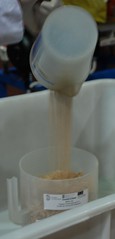Determinación de la densidad a granel (UNE-EN 15103)
La densidad a granel es un parámetro importante para los suministros de combustibles en base al volumen y, junto con el poder calorífico neto, determina la densidad energética. También permite estimar las necesidades de espacio de almacenamiento y de transporte.
Normativa aplicable
-
UNE-EN 15103 Biocombustibles sólidos. Determinación de la densidad a granel.

Recipiente pequeño
Equipos empleados
-
Recipiente grande: recipiente cilíndrico con una relación altura-diámetro entre 1.25 y 1.5 y un volumen de 50 litros. El recipiente grande puede ser empleado para todo tipo de muestras.
-
Recipiente pequeño: recipiente cilíndrico con una relación altura-diámetro entre 1.25 y 1.5 y un volumen de 5 litros. El recipiente pequeño puede ser empleado para combustibles con tamaño nominal hasta 12 mm y para pélets de diámetro igual o inferior a 12 mm.
-
Balanza 1: balanza que permite pesar la muestra y el recipiente grande con una aproximación de 10 gr.
-
Balanza 2: balanza que permite pesar la muestra y el recipiente pequeño con una aproximación de 1 gr.

Balanza 2
-
Tamaño nominal o diámetro de pélets superior a 12 mm: volumen de muestra requerido de 65 litros.
-
Tamaño nominal o diámetro de pélets igual o inferior a 12 mm: volumen de muestra requerido de 6.5 litros.

Llenado con la muestra
-
Selección del recipiente: se empleará el recipiente pequeño en caso de que el tamaño nominal de la muestra o el diámetro de pélets sea igual o inferior a 12 mm, en caso contrario se empleará el recipiente grande.
-
Determinación del volumen del recipiente: se determina el volumen de recipiente en base a la diferencia de masa del recipiente lleno de agua y el recipiente vacío, suponiendo una densidad del agua de 1000 kg/m3.
-
Llenado del recipiente con la muestra: se deja caer la muestra sobre el recipiente desde una altura entre 20 y 30 cm hasta formar un cono de altura máxima.
-

Retirada de material sobrante
Asentamiento de la muestra: se somete al recipiente lleno de muestra a sacudidas, dejándolo caer desde una altura de unos 15 cm, para que la muestra se asiente. A continuación se rellena el espacio vacío y se vuelve a sacudir.
-
Retirada del material sobrante: se retira el material sobrante pasando un pequeño escantillón por el borde del recipiente con movimientos oscilantes.
-
Pesaje del recipiente: se pesa en recipiente lleno de muestra y vacío.
-
Réplica de la medida: se realizan al menos dos réplicas de la medida.
Resultados del ensayo
-
Densidad a granel según se recibe la muestra.

Cono de altura máxima
-
Densidad en base seca (opcional): se requiere la determinación del contenido en humedad en estufa.
The bulk density is an important parameter for the fuel supply and, together with the net heating value, it determines the energetic density of the fuel. Furthermore, the knowledge of the bulk density permits the estimation of the space needed for storage and transport of the fuel.
European Standard
-
EN 15103 Solid biofuels – Determination of bulk density.

Small vessel
Apparatus
-
Big vessel: cilindrical vessel with an aspect ratio (height-diameter) between 1.25 and 1.5 and a volume of 50 liters. The big vessel can be employed for all kind of samples.
-
Small vessel: cilindrical vessel with an aspect ratio (height-diameter) between 1.25 and 1.5 and a volume of 5 liters. The small vessel can be employed for samples with a nominal size under 12 mm and for pellets with a maximum diameter of 12 mm.
-
Scale 1: scale capable of measuring the mass of the sample and the big vessel with an approximation of 10 g.
-
Scale 2: scale capable of measuring the mass of the sample and the small vessel with an approximation of 1 g.

Scale 2
-
Nominal size or pellets diameter over 12 mm: sample volume requiered of 65 liters.
-
Nominal size or pellets diameter under 12 mm: sample volume requiered of 6.5 liters.

Fill up with the sample
-
Vessel selection: the small vessel will be employed for samples with a nominal size of 12 mm or pellets with a maximum diameter of 12 mm. For bigger samples the big vessel will be employed.
-
Determination of the vessel volume: the volume of the vessel will be employed based on the difference in mass of the vessel filled and the empty vessel. A density of 1000 kg/m3 will be assumed for water.
-
Filled up of the vessel: the sample will be dropped over the vessel for a height between 20 and 30 cm until a maximum height cone is formed.
-

Removal of the excess material
The vessel containing the sample will be dropped from a height around 15 cm in order to settle the sample in the vessel. Then the empty space in the vessel will be filled with extra sample.
-
Removal of the excess of sample: the sample contained over the height of the vessel will be removed using a ruler, producing an oscillanting motion over the edge of the vessel.
-
Determination of the mass of the vessel: the vessel will be weighed both empty and filled with the sample.
-
An extra measurement will be carried out in order to prove the repetibility of the process.
Experimental results
-
Bulk density of the sample.

Maximum height cone
-
Bulk density of the sample on a dry basis (optional): thedetermination of the moisture content is requiered.